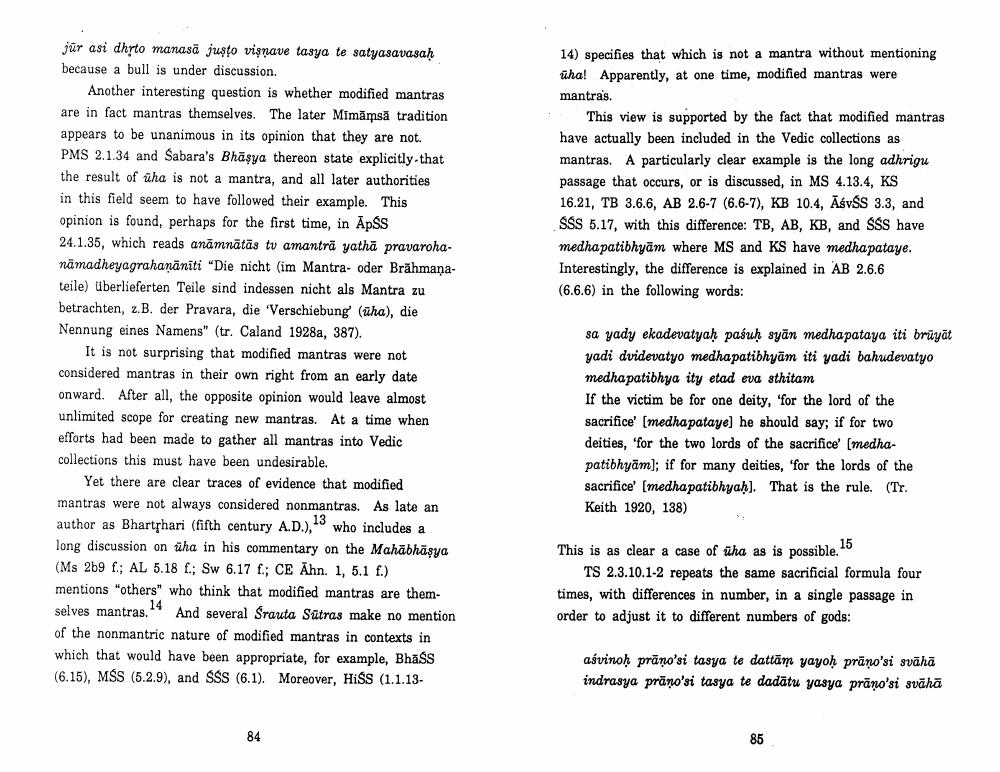Book Title: Paninian And Veda Reconsidered Author(s): Johannes Bronkhorst Publisher: Johannes Bronkhorst View full book textPage 6
________________ 14) specifies that which is not a mantra without mentioning tiha! Apparently, at one time, modified mantras were mantras. This view is supported by the fact that modified mantras have actually been included in the Vedic collections as mantras. A particularly clear example is the long adhrigu passage that occurs, or is discussed, in MS 4.13.4, KS 16.21, TB 3.6.6, AB 2.6-7 (6.6-7), KB 10.4, ĀsvŚs 3.3, and SSS 5.17, with this difference: TB, AB, KB, and SŚs have medha patibhyam where MS and KS have medha pataye. Interestingly, the difference is explained in AB 2.6.6 (6.6.6) in the following words: jur asi dhrto manasi justo vişnave tasya te satyasavasah because a bull is under discussion. Another interesting question is whether modified mantras are in fact mantras themselves. The later Mimāmsă tradition appears to be unanimous in its opinion that they are not PMS 2.1.34 and Sabara's Bhäşya thereon state explicitly that the result of üha is not a mantra, and all later authorities in this field seem to have followed their example. This opinion is found, perhaps for the first time, in Apss 24.1.35, which reads anāmnātās tv amantra yatha pravarohanāmadheyagrahaņāniti "Die nicht (im Mantra. oder Brāhmanateile) überlieferten Teile sind indessen nicht als Mantra zu betrachten, z. B. der Pravara, die 'Verschiebung (üha), die Nennung eines Namens" (tr. Caland 1928a, 387). It is not surprising that modified mantras were not considered mantras in their own right from an early date onward. After all, the opposite opinion would leave almost unlimited scope for creating new mantras. At a time when efforts had been made to gather all mantras into Vedic collections this must have been undesirable. Yet there are clear traces of evidence that modified mantras were not always considered nonmantras. As late an author as Bharthari (fifth century A.D.)," who includes a long discussion on üha in his commentary on the Mahabhäşya (Ms 2b9 f.; AL 5.18 f; Sw 6.17 f.; CE Ähn. 1, 5.1 f.) mentions "others" who think that modified mantras are themselves mantras." And several Srauta Sutras make no mention of the nonmantric nature of modified mantras in contexts in which that would have been appropriate, for example, Bhass (6.15), MSS (5.2.9), and SSS (6.1). Moreover, HiśS (1.1.13 sa yady ekadevatyaḥ paśuḥ syān medha pataya iti brüyat yadi dvidevatyo medha patibhyām iti yadi bahudevatyo medha patibhya ity etad eva sthitam If the victim be for one deity, 'for the lord of the sacrifice' (medha pataye) he should say; if for two deities, 'for the two lords of the sacrifice' (medhapatibhyām]; if for many deities, 'for the lords of the sacrifice' (medha patibhyah). That is the rule. (Tr. Keith 1920, 138) This is as clear a case of üha as is possible. TS 2.3.10.1-2 repeats the same sacrificial formula four times, with differences in number, in a single passage in order to adjust it to different numbers of gods: asvinoh prāno'si tasya te dattām yayoh prāno'si svāhā indrasya prāno'si tasya te dadātu yasya prāno'si svāhāPage Navigation
1 ... 4 5 6 7 8 9 10 11 12 13 14 15 16 17 18 19 20 21 22 23 24
